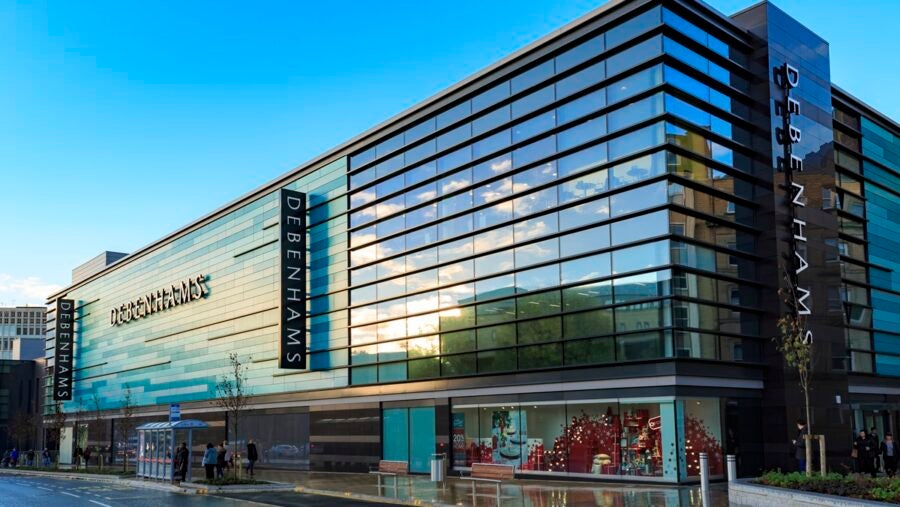
Hot on the heels of the not-so-well-received reimagining of Pretty Little Thing, its parent company, Boohoo Group, announced its own rebrand to the Debenhams Group. This comes amid a major shake-up of the company’s senior management, with Daniel Finley, the former Debenhams’ CEO, taking control of the business in late 2024.
What has actually changed?
Despite some misleading headlines, Boohoo the brand remains intact. The change applies to the parent company, not the individual labels under it. The goal appears to be adopting Debenhams’ successful marketplace model, where each business sells multiple brands from its online storefront.
The group has also introduced a new “DG” logo to its existing logo. The purpose is clear enough: leadership wanted to introduce a contemporary feel to the group and differentiate itself from the trading brand. Unfortunately, this just adds a layer of confusion and undoes some of the impressive brand memorability and respect the original logo possesses.
Replacing a bad reputation
Boohoo’s reputation and value have been in decline after peaking during Covid-19. For a few years, the retailer has been plagued by questions about sustainability and quality. The Debenhams name, however, still holds weight. More importantly, since Boohoo acquired the department store in 2021, Debenhams has rallied, reporting a 65% year-on-year revenue growth in the 12 months to December 2024.
For shareholders, Debenhams now has a reputation for being a value-generator – it is lean, fast and technologically advanced. Its portfolio of brands, including Boohoo, will be borrowing from that respectability and legacy.
Getting brand architecture right
When it comes to portfolio businesses, leaders must manage brand architecture effectively and organise sub-brands in a way that helps customers understand and relate to them. This means clearly establishing the identity and positioning of each sub-brand, leveraging the reputation of the parent group to enhance the reputations of the member brands and encouraging high-performing brands to share resources and train lower performers within the portfolio.
Prior to a rebrand of this scale, decision-makers must consider five key things:
Aims and aspirations. Question what you want to achieve for this group of brands. Doing so will help you to understand whether there is a natural brand architecture to work with.
Brand strengths and roles. How strong are the individual brands and what role do they play in the portfolio? Assess each brand’s strengths through their value, awareness, equity and distinction. This also enables you to identify duplication in the portfolio, which should be underpinned by both external and internal perspectives.
Customer needs. With any brand, you need to consider what makes sense to your audience or, in this case, audiences.
Best practices. Identify what others are doing in the market – particularly what they’re doing well. Your competition is just that – competition, but that doesn’t mean you should needlessly break the mould. Think about learning from other markets and industries too. You can find valuable lessons everywhere if you look hard enough.
Constraints. Get your internal stakeholders in a room and be honest about the obstacles and constraints facing your business.
Has Boohoo got it right?
In Boohoo’s case, the rebrand points to an ambition to strengthen the portfolio as a whole. But has it effectively addressed brand roles, differentiation and customer perception? While the new Debenhams Group structure might improve investor confidence, it’s unclear whether customers will understand the shift or whether the Boohoo brand’s weaknesses will simply persist under a new name.
Without clear differentiation and a more compelling narrative, this rebrand could be seen as little more than a cosmetic fix for deeper brand issues. Only time will tell whether the move will help Boohoo rebuild its reputation or if it’s simply putting a new name on an old problem.
Sue Benson is CEO and founder of creative agency The Behaviours Agency

Hot on the heels of the not-so-well-received reimagining of Pretty Little Thing, its parent company, Boohoo Group, announced its own rebrand to the Debenhams Group. This comes amid a major shake-up of the company's senior management, with Daniel Finley, the former Debenhams’ CEO, taking control of the business in late 2024.
What has actually changed?
Despite some misleading headlines, Boohoo the brand remains intact. The change applies to the parent company, not the individual labels under it. The goal appears to be adopting Debenhams’ successful marketplace model, where each business sells multiple brands from its online storefront.
